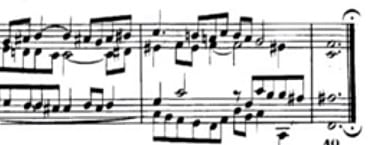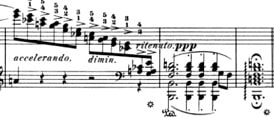As an Amazon Associate I earn from qualifying purchases.
Have you ever heard a piece of music that ended a little differently than you would have expected? If so then chances are what you encountered was a Picardy third.
So what is a picardy third? A picardy third is a cadence used at the end of a minor key piece where it resolves to a major tonic chord instead. This is accomplished by raising the 3rd note of the chord by a semitone. The Picardy third is commonly used in Baroque and Renaissance-era music.
The Picardy third is used more widely in today’s evolving modern music. However, it is a very old technique that has been employed for centuries. I’ll dive into a little bit of the history of the Picardy third as well as ways it’s used now, how it’s used in piano pieces, and some other variants of the technique.
Origin Of The Picardy Third
While most music terms have a definitive history the same cannot be said for the Picardy third. In fact, no one really knows the true origin of the term.
It is also referred to in some of Bach’s music as Tierce de Picardie. While we know that Tierce means “three” in French, there’s no definitive answer as to where Picardy comes from.
There is some speculation that it refers to the French province Picardy. Others believe the term comes from the French word “picart”. Because a Picardy third involves raising the third note of the chord, the word the “picart” may be referring to “sharp” as it’s meaning in certain dialects of the language.
The first official instance in which the Picardy third was introduced in music wasn’t 1727 by French composer Jean-Jacques Rosseau. He’s was innovative in his time, developing different notation systems, writing operas, and pioneering aspects of music theory.
Originally polyphonic compositions between years 500 – 1400 ended with a lot less stability. In fact, the third was omitted altogether in concluding harmonies as that was not seen as a proper way to end pieces at the time.
Instead of a full chord as we know it now, those pieces ended with open 5ths or basic thirds.
As music evolved in the Western region, the Picardy third was developed allowing for a more stable closure with a complete triad formed with a supporting root and 5ths.
What Makes The Picardy Third So Unique
The Picardy third was widely used in the late 15th, 16th and 17th century, although it was used less frequently in Classical-era works.
The uniqueness of the chord was special than at a time when many pieces were written in minor keys. The goal of this major chord was to bring about a “happy” closure to the work.
Many composers from Bach to Beethoven employed this chord at the end of their minor works to help bring calm to the listener who might have felt disturbed by the flat third note as most minor pieces have.
In the 16th century especially, the Picardy third was used for very specific reasons. Sometimes it had to do with the acoustics, and other times the harmonies.
Keys in minor keys always lacked the clear tuning that a major key could provide, so it was more desirable to end on a major chord. The major chords also offered a firmer sense of conclusion to a piece.
In Classical pieces, there are instances where the piece is in Binary form. The first section of the work might be in a minor key, but the entire second section would be in a major key and cadence as such. The relations of those two sections were almost always the parallel major or the relative major in relation to the original minor key.
Does The Picardy Third Always Occur At The End Of A Piece?
There’s a common misconception that the Picardy third will always be found at the end of a piece. That’s not necessarily the case.
In fact, the Picardy third can be used at the conclusion of any relevant cadence or line as long as it’s proceeded by a minor key.
While it’s not that common to see Picardy thirds in the middle of a piece, it makes sense to do this when modulating from one key to the next. Pieces that start in a minor key and want to make the transition much smoother will sometimes cadence on the major tonic of the minor key, and then proceed to start a new section on the dominant of the new key.
Most often this takes place when using parallel majors. Ideally, a piece won’t employ too many Picardy thirds as it could give a false sense of conclusion.
Examples Of Picardy Thirds In Piano Music
If you’re a pianist, chances are you’ve seen Picardy thirds at some point. Let’s take a look at the following examples of where it happens in some popular pieces.

The above example is from Bach’s F sharp minor Fugue. Normally in F sharp minor, the A would be natural. Looking at the last measure the piece cadences on an F sharp major chord. This is because the A is raised, making it an A sharp.
Some pianists take the liberty of ignoring the A sharp, however, it does add a nice bit of unique flavor for the audience to end it on a Picardy third.

In the next example, we have the Beethoven Sonata No. 5 Movt 3. This movement is in C minor which is clearly indicated by the key signature.
As the piece arrives at a close you can see that Beethoven starts prepping the realization a few measures out from measure 120. Eventually, though, he gives a definitive C minor chord in measure 120 and then finishes it off at the very end.

While the Picardy third is used a lot less as time goes on, Romantic composers such as a Chopin made frequent use of it. Chopin’s Nocturne No. 1 in B flat minor is a prime example of this.
He uses a falling sequence of thirds which helps set up the dominant chord before the last measure. Then he simply ends the piece on five B flat major chords, similarly to how Beethoven prepares the listeners ear.
On a piece like this with an overall dark tone, the chord at the end represents relaxation and hope.
What About The Reverse Picardy Third
While there is no official name for the term, there are some instances where a Picardy third will happen in the reverse. For example, in Satie’s Gymnopedie he begins this piece in a major key and then concludes in a minor key.
In general, musicians will not encounter this very often. For one it’s much harder to pull off and have the piece still sound tasteful. Secondly, the piece will have less harmonic closure, and in essence, feel unfinished.
There are some situations where pieces are in binary form, and the first section is major while the second section is minor. On a phrase by phrase basis, this also might occur.
The main uses for the technique would be to change the mood of the listener. For example, a water piece about a bubbling brook may start in a major key, but ultimately conclude in minor when the water dries up. Usually pieces that have a story attached will employ this feature.
Hello & thanks for stopping by! I’m a professional concert pianist and piano instructor. In the United States, I’ve given successful performances in several places including New York, Florida, Connecticut, & New Jersey, I have also performed internationally in Italy and made my Carnegie Hall debut in 2014. I enjoy blogging about the piano, the art of performance, general music, current events and the latest in music production.
